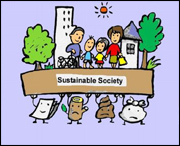Energy from biomass
Biomass is one of the oldest and most important sources of energy, used by the humans up to present time.
The flame, which was discovered more than four thousands years ago, became the basis of a significant increasing of the humans quality of life. The firewood was for a long time an important part way of lives of the wholes groups of society. The biogenic fuel as a result of industrial revolution was replaced by the fossil fuels.
Presently more fossil fuels is burned, as was generated in the last thousands of years. Increased risk of the environment and of the whole ;life on the earth reworked the awareness of the return to the traditional environmentally friendly biomass energy carriers. Because the biomass is a biological substance of plant origin it is not generated energy carrier. Contemporary more and more developed countries of the world has awareness of the limitations of fossil fuels and the risks involved o fit.. Therefore, the priority are receiving the renewable energy carriers (ONE).
For to strength energy security and independency of the European Union countries on supply of energy from troublesome countries and regions, diversification of energy sources is one of he principal approaches . Their use is one of the possible ways of reducing the dependency on fossil fuels and on reducing . emissions into the environment. Practically it means to increase the share of energy from
renewable sources of the total amount of energy consumed. For Slovakia in terms of its geographic location, structure and coverage of the surface area forests, meadows and land biomass is a key energy carrier. The term biomass means all organic substance, created by photosynthesis, or of material of animal origin. It is basically preserved in post solar energy by plants through photosynthesis, converted to organic matter. Net biomass is assigned to the category of biofuel. with mass fractions of combustible h, ash A. and water equal to one-Ie W.
It is:
h + W + A = 1
Biomass is important not only as a source of energy, but can contribute to improving economic and social conditions in economically disadvantaged regions. Slovakia n comparison to the former member states (EU 15) ls behind in the use of biomass as a renewable energy carrier. According to the Ministry of Economy biomass presently accounts for about 4.8% of primary energy sources. According to forecasts of climate conditions, such as those in Slovakia is real potential for energy from biomass 12-14% share of total energy consumption. To implement the strategic goals of the potential of biomass, the Government approved a number of policy and program documents, which are based on EU Energy Policy and Action program for Biomass adopted by the European Commission.
Basis for European energy policy can be considered strategic objectives expressed by the 3x20 model. In practical terms, the model means:
- Energy savings of 20% compared to the plan in 2020,
- Reduction of greenhouse gas emissions by 20% compared to 1990,
- 20% share of energy from renewable sources of energy in total consumption,








